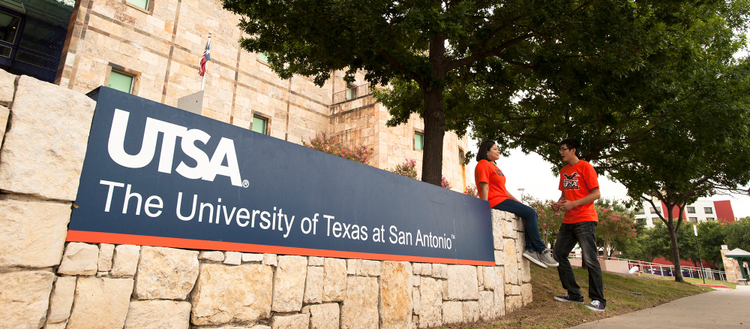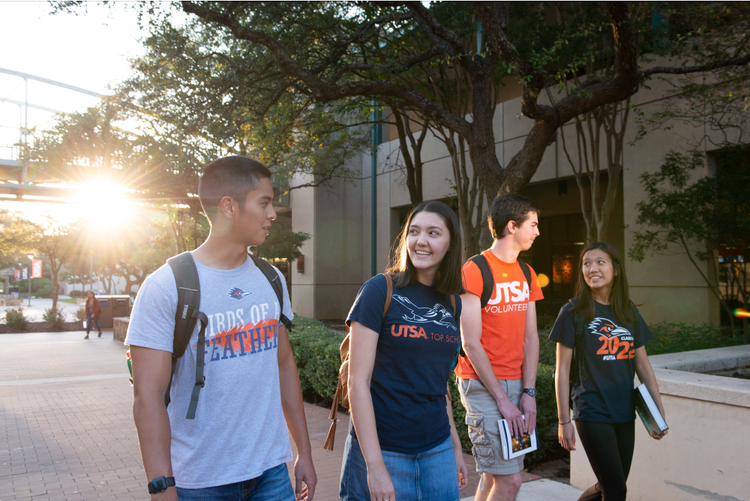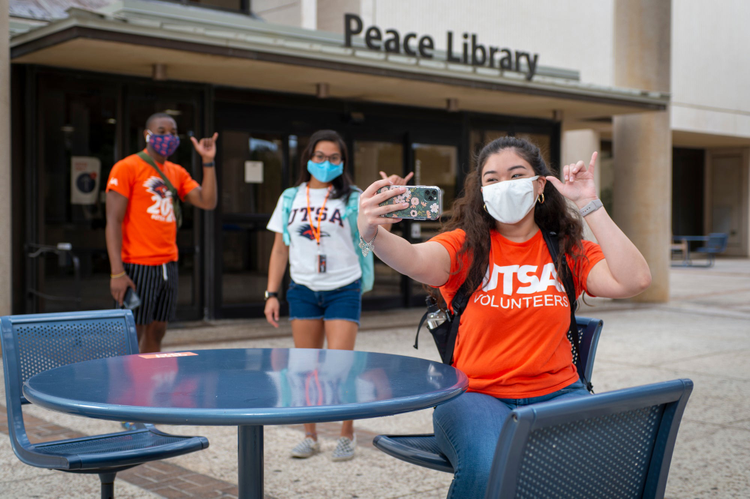University of Texas at San Antonio builds community and prepares students for career success with Adobe Creative Cloud

The University of Texas at San Antonio (UTSA) is one of the younger universities in the University of Texas system. But in the 50 years since its founding, UTSA has had a remarkable impact on the state and community. UTSA was founded to serve San Antonio’s culturally rich, predominantly Mexican American population. The university received recognition as a Hispanic Serving Institution (HSI) and it was recently named the ninth top university in the United States for granting undergraduate degrees to Hispanics.
Part of what makes UTSA such a well-respected institution is its commitment to career preparation. It strives to give students not only the knowledge but also the skills they need to succeed and thrive. Melissa Vito, vice provost for Academic Innovation at UTSA, spearheads many of the efforts to support student academic and career success. When studying the modern work landscape, she discovered that the most important skill for students in any career is digital literacy.
“Building digital literacy is essential for any field of study. Students need to learn how to communicate ideas and gain skills that that will serve them well throughout their careers,” says Vito. “It’s also vital for UTSA faculty to find creative approaches to teaching to improve student learning, whether we’re working with students online or in classrooms.”
As an Adobe Creative Campus, all UTSA faculty, students, and staff have access to all of the Adobe Creative Cloud apps. While Adobe Creative Cloud apps are standard in many schools for art and design students, UTSA believes that every student can benefit from learning to use Adobe Creative Cloud.
The university works with faculty champions in each department to identify needs, share resources, and build a community of active users. Today, Adobe Creative Cloud is used in more than 50 classes serving hundreds of students. Creative Cloud usage has grown up to 50 percent year-over-year, with 700 students, faculty, and staff attending 150 training sessions to learn more about apps.
“For our students to succeed in tomorrow’s workforce they must be digitally fluent. It’s critical that they have the tools to make sense of data and communicate that meaning to others,” says Taylor Eighmy, president of UTSA. “Through the Adobe Creative Campus program, we put the infrastructure in place to teach our students how to tell stories. The partnership between UTSA and Adobe is not merely transactional — it’s transformational.”

Inspired exploration opens new doors
The Academic Inquiry and Scholarship (AIS) department takes UTSA’s classroom-to-career mission to new heights. In AIS classes, first-year students explore their professional interests in more detail and learn about careers that will help them meet their goals. Elena Camargo is one of the instructors in AIS focusing on Life and Health Sciences.
“The whole idea behind the AIS course is that we want to help students find their passions,” says Camargo. “I want to get students engaged with every assignment. Adobe Creative Cloud apps are fantastic for student engagement, because when you give students more freedom and allow them to explore a project creatively, they become more invested in whatever they’re doing.”
One of the biggest projects in the course involves students interviewing someone working in their preferred career field. Students thinking about working in a surgical position might interview an orthopedic surgeon to learn what a typical day looks like and what difficulties she faced along her career path. After interviewing a subject, students create a video exploring what they learned. Camargo likes that Adobe Creative Cloud includes a variety of apps — Adobe Creative Cloud Express, Adobe Premiere Pro, or Adobe Premiere Rush — that students can choose from depending on their level of video editing knowledge and the type of video they want to create.
Camargo encourages students to work with Adobe Illustrator to create informational posters about a controversial topic related to ethics in health sciences. Learning to work with Illustrator to represent compelling information visually is an important skill that students can carry with them into any future career.
For the signature experience project, Camargo asks students to brainstorm a solution for a life-sciences or health-sciences issue. The solution might be a product, service, or even an app. Students then create an Adobe Creative Cloud Express presentation to share their solution with the class. Some students have even used Adobe XD to quickly create a prototype app that brings their ideas to life.
“Teaching digital literacy is essential in today’s world,” says Camargo. “This is particularly true as remote working, learning, and healthcare become more commonplace. We need to make communications as interactive as possible to preserve that feeling of sharing and connecting more with others.”
Bridging departments to build community
Strengthening community is the focus of a recent interdisciplinary project at UTSA. History professor Jodi Peterson believes strongly in the role that community and collaboration play in learning. It’s why she works with colleagues from across disciplines as part of a Tactical Team that develops experiential learning opportunities for students.
When thinking about the many changes that her students have experienced over the past few years — pandemic, political change, social justice movements, economic uncertainty, and growing online lives — Peterson wondered how her students were coping. As a historian, she thought it might be interesting to capture the voices of UTSA students to create a record of these unprecedented times while helping students grapple with their own feelings.
Through the Tactical Team, she reached out to instructors, designers, videographers, and librarians from across UTSA departments to embark on a new type of interdisciplinary project that ultimately attracted participation from 500 students across six disciplines.
- History: Students created a journal entry that reflects on a defining moment in their recent history, then contrasted their experiences by creating a journal entry imagining how a historical moment in their ancestors’ lives might have affected them.
- Creative writing: Students wrote poetry based on the content, history, and emotions expressed within the journal entries.
- Art: Students created visual artistic representations based on the journals entries and poetry.
- Music: Students developed new musical compositions inspired by the poems.
- Dance: Students translated the musical compositions into dance, bringing a visual representation back into the experience.
- Architecture: Students designed stages and exhibits that assemble each chain of experiences into a showcase.
Students used Adobe Creative Cloud apps throughout the project. Since all students have access to the same apps, they could easily share each part of their experience for greater collaboration. Many students praised the project for how it helped them feel connected and heard, even during such difficult changes in their lives.
“I felt like someone could hear my story and my pain,” said one UTSA student. “Seeing how deaths are treated as a statistic and people are still going out, it feels like people don’t understand the consequences of their actions. I feel like I have a platform to speak on.”
Peterson believes that this project might form the foundation for how disciplines can work together, create a community, and empower students to explore their identities while at UTSA.

Tracking academic progress
While mathematics may not seem like a logical subject for creativity and expression, lecturers Jonathan Brucks and Carolyn Luna believe that it plays a big role in the success of their Business Algebra class.
“Many students question the importance of math in their lives and in their careers,” says Brucks. “We realized that giving students a way to reflect on what they’ve learned and track their progress, even across their time at UTSA, could be very valuable to them.”
Brucks and Luna ask students to use Adobe Portfolio to create an ePortfolio for their class. Students create a bio page, upload assignments, and incorporate content in a variety of mediums. As students progress through their academic career, they can create new pages for each course they take. After a few semesters, this will create an impactful, visual record of what students have learned and how all of their lessons connect together to aid their future careers.
One student, Nicholas Crouse, created an ePortfolio that displays the answer to each challenge question as a colorful infographic, with his reflection responses added text beneath each image. By contrast, Shaune Gross completed all of her class assignments with pencil and paper, adding scans of her hand-written pages to share the work digitally. Both students also include two video presentations that allow them to walk through their solutions to complex questions. Gathering assignments in the ePortfolios makes it easy for students and instructors to review all responses in one location.
“A lot of students have already approached us and said that they appreciate the opportunity to work with Adobe Creative Cloud apps and explore through ePortfolios,” says Luna. “It’s an important opportunity for us to hear students’ voices and let them tell us what they care about. Students are willing to be more open minded about mathematics because we give them the freedom to express themselves and be creative.”
By continuing to find new ways to use Adobe Creative Cloud in all classes, UTSA aims to keep connecting students and creating a strong community. “By providing access to Adobe Creative Cloud applications, we’re supporting students in their creative digital storytelling and helping them build skills that will support their future careers,” says Vito.
Learn how you can build digital literacy at your school here.